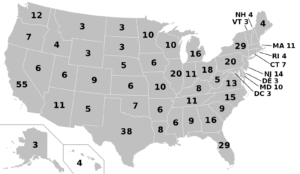Under the US constitution, it states that the presidential elections must function through a process of the electoral college, in which each state has a certain number of electoral votes allocated to them. It is a complicated and heavily debated system, but below is a short explanation of the way the fate of the upcoming election will be decided. An electoral college for dummies, you might say.
The electoral college is the very system that allowed for Donald Trump to be appointed in 2016, despite getting less votes than Hillary Clinton, and some worry that the same thing will happen this year against Joe Biden.
When Americans cast their vote, they are technically not voting for a presidential candidate, but rather for said candidates’ presidential electors. Each state, as well as Washington DC, has a number of electors, adding up to a total of 538 representatives who decide the fate of the election, and whichever candidate wins the most amount of electors wins the election. However, if no candidate wins a majority of 270 electoral votes, the election is determined by a contingency vote.

The amount of electoral votes of each state is determined by the congressional districts in the state, but they’re often not representative of the population of the state. Each state must have a minimum of 3 electoral votes, which mean smaller states like North and South Dakota are overrepresented, whereas large states like Texas, California and Florida are underrepresented. This is the leading cause behind the criticism of the electoral college, as it tends to favour republican seats, seeing as republican voters are more common in rural areas, whereas democrats are more likely to be found in urban cities with fewer electoral votes per capita.
The system works so that the candidate with the most votes per state wins all electoral votes of that state, no matter the voter split margin within the state. The only exception to this rule are in Main and Nebraska. For example, Biden is likely to win in California, a known blue state, meaning he will take home all 55 electoral votes of the state. This is why there is such a big focus placed on so called swing states, where the outcome is hard to predict. Florida is one of those states, and in 2016, Trump beat Clinton by a mere 2.2% in the state, but still secured all 29 Floridian votes.
On election night, results usually flood in state by state, until the winner is clear. However, this year, only 8 states are predicted to have a result by election night, largely due to the huge increase in postal voting. The order in which different types of ballots are counted varies state by state, meaning that the results of many key states won’t be clear until after the night. This also means that the initial results may not be accurate, and we may not know the winner of the 2020 US presidential elections until Thursday.



